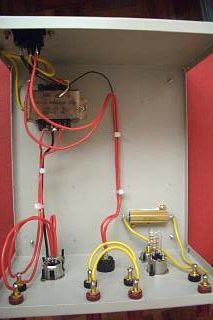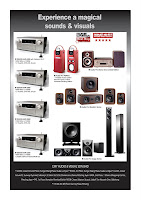
Here it is! My DIY version of a kable kooker.
First a declaration before I proceed with this article. I have never seen the actual Audio Dharma Cable Cooker before embarking on this project. I have, however seen some pictures available here on this blog and else where on the www.
 The rear panel with IEC and fuse holder.
The rear panel with IEC and fuse holder.I just made an educated guess that it will sort of work this way, and along the way have the guiding hand of a senior DIYer. From the photos and pictures I've seen, the commercially available cable cooker works by supplying 12V A/C to the cables and applying the appropriate resistance to each intended cable to simulate the necessary load, like 8.2 ohms @ 50W for speakers cables, 75 ohms @ 2W for RCA and 100 ohms @ 2W for XLR interconnects.
 The transfomer, note ratings.
The transfomer, note ratings.To start with a 6V 0 6V @ 3 amps rated transformer is used to step down from our 240V wall supply via an IEC socket and ON/OFF switch with indicator, fused with 0.5 amp 30mm fuse, for safety purposes. From the step down voltage of 6V 0 6V, power is parallel supplied to the out put speaker connectors, RCA and XLR connectors. On the receiving end of connectors, are resistors attached, to simulate load on the cables when connected to form an electrical loop. See connection picture for a better idea.
 The internals, note the load resistors on the right side.
The internals, note the load resistors on the right side.Like the commercially available unit in use, the DIY kable kooker will need some adaptors to work. It will need a female - female RCA connector to cook a pair of RCA simultaneously. It will also need a speaker(spade/banana) connector - wall plug converter and an IEC - speaker(spade/banana) connector for cooking power cords, which I have yet to build, but can easily do so should the need arises.
 Another look at the connections, from the back. Note that everything is reversed!
Another look at the connections, from the back. Note that everything is reversed!For XLR interconnect cooking, just connect the pair of XLR's output to input before routing them back to the kable kooker to form an electrical loop.
 Kable Kooker in action, top is back panel, bottom is front panel. Abbey Road speaker cables and AQ Sky XLR cooked in pairs simultaneously.
Kable Kooker in action, top is back panel, bottom is front panel. Abbey Road speaker cables and AQ Sky XLR cooked in pairs simultaneously.It was a fun and easy project for me as it took about 2 hours to finalise component list, circuit and layout. Half a day at Jalan Pasar(Kuala Lumpur's electronics supply area) to pick up the parts and another one day to drill the necessary holes, fit all the plugs, sockets and connectors plus finally, wiring it all up.
 Another cooking view from front panel.
Another cooking view from front panel.The kable kooker project was born out of the necessity to cook the Abbey Road speaker cables reviewed earlier. Whilst at it, I also took the opportunity to cook my AQ Sky XLR pair of interconnect. I can in fact use the kable kooker to cook all 3 types of cables in pairs at one go! that's how versatile it is. Like the Audio Dharma unit, the DIY kable kooker runs rather warm when doing it's job. The RCA and XLR sockets should also run a little warm when cables are inserted for cooking.
I do not have the chance to A/B it's effectiveness against the "Real McCoy" but my own subjective post cooked cable experiences echoes those of the Audio Dharma users reported here earlier.
The usual DIY caveat applies should you decide to build one for yourself. I cannot be held responsible for any loss, damage equipment, shock hazard, injuries or death as a result of negligence from following my posting here. Please DIY at your own risk.







10 comments:
not bad.quite cleverly done....
panzer,
clap, clap, clap.
you are a clever boy ;-)
Panzer,you are very smart.You can do a lot of things.I admire you a lot.You are very good.Is there any chance so that I can meet up with you?If there is,thank you.
Panzer,
Your DIY kable kooker is like a stimulus package to us mainstreet, no, make it backstreet guys.
I am most glad to note the kooker comes from the initiatives of an entrepreneur from an emerging market.
I think it can provide an economical and viable alternative to those caught in the vicious cycle of punting after inflated audio assets which now can be best valued as toxic audio derivatives(fomerly known as sub-prime).
The kooker does provide leverage to those who want to cook their cables at real world prices.
Consider it to be ahead of the audio curve.
Congratulations and may you provide more deleveraging audio solutions to us in these rather grainy and illiquid times.
Panzer, great work there. But with due respect, the real McCoy has one more thing that will help greatly in the breaking in of cables ie. the extended frequency sweep (random I believe) that goes into the cables.
You can think of how to put a frequency generator into the cooker to make it even better. Attached is the link to the Audio Dharma website.
http://www.audioexcellenceaz.com/audiodharmacablecooker.htm
I fully agree with GCK.
In my experience of using the various cable cookers[including the Nordost one}the Audiodharma is better by a considerable margin.
I suspect the unique frequency sweep plays an important part in this regards.As you perharps know,If you sell the Valhallas and the Odin,You are required {by Nordost] to precook the cables before giving them to the custumers...and this regards,most dealers actually prefers the Audiodharma
Both GCK and Karl are correct.Not to put water to fire,this effort by Mr Panzer is certainly commendable.
My experience suggest that AudioDharma offers something more than what has been described...
panzer,
time to do a a/b and see if the
diff in cost justifies or not...
chan-as, maggielurva, km,
Thanks for the kind compliments.
Marthew,
Thank you for the very, very, flatering words. Should it be destined for us to meet, I am very sure we will.
GCK, karl, Hoest,
Thanks for you opinions & pointers. Will certainly learn more about the frequency sweep generator in the Audio Dharma.
built62,
Will try to get a chance to A/B cable cookers when possible. This is exciting.
Couldn't find an e-mail link, but to let you know. I have linked to this article on my website. I used an image of your cooker in the article, I hope this is alreight? If not can you get in touch with me and I will pull the article.
http://www.justblair.co.uk/diy-audio-cable-cooker.html
I like your solution, whilst not a clone it is pragmatic and elegant.
Post a Comment